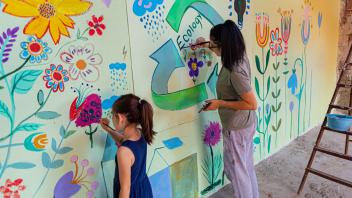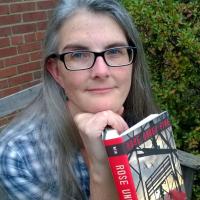Five of the Little House books, By the Shores of Silver Lake, The Long Winter, Little Town on the Prairie, These Happy Golden Years and The First Four Years, take place in De Smet, Dakota Territory (later South Dakota). We planned a few days here to get at least a taste of prairie life past and present and to savor the place where so many of Laura’s stories happened.
Breece and I were especially enthusiastic about our lodging in De Smet, but for different reasons. The Heritage House Bed & Breakfast , built in 1888, sits right across the street from the historical site of Pa’s building where the Ingalls spent the Long Winter! The Long Winter is my favorite title of the series and I was excited to sleep so close to the very space where the family spent those long, cold months grinding wheat and twisting hay. Breece though was more impressed with our spacious three-room suite with a loft! And with the fact that we were sleeping in a place that was once a bank. He even got to check out the original bank vault, which is now a tiny office.
From the windows of our suite, we could see a good bit of the very Main Street where Laura first felt nervous and crowded in by strangers but then later enjoyed sleigh rides with her friends and beau. Since we were so close to Pa’s building site, we could easily imagine her view of the little town. According to this map of De Smet , we were looking across Main Street to the spots where the Wilder’s Feed Store and Fuller’s Hardware once stood. Looking further down Main Street, we could also see the still operational Loftus General Store — where Laura and Carrie bought suspenders for Pa one Christmas. A walk down Main Street was in order, but so was some rest and relaxation in our beautiful rooms.
The next morning, we toured one block of Main Street — where every building includes a sign describing what business was originally there—and gathered supplies for a picnic lunch. We’d decided to take advantage of the sunny forecast and head out to the Ingalls’ Homestead for the day.
The Ingalls’ Homestead is the very land that Pa filed a claim on in early 1880 and proved on in 1886. The land is now privately owned, but generously shared with the public as an attraction with a knowledgeable staff and many hands-on activities to introduce families to prairie life and homesteading.
___
Since Breece and Avery gamely tried all the Ingalls’ Homestead had to offer, here are their perspectives on the place:
Breece: So this place was a “Little House” place but not so little for a change. Nama (Janet) bought our tickets and we watched a short movie and then went outside. There was a lookout and we climbed up and could see all the places and things to do. The closest thing looked like a playground, so Avery and I went down the stairs to check it out.
Avery: The playground seemed like it was supposed to be historic. The seesaw was made of a plank of old wood and metal wagon wheels. There was a merry-go-round too and it was fun because playgrounds don’t usually have those anymore. Breece and I played for a while until we saw Aunt Rachael and Nama go into the building next to the playground.
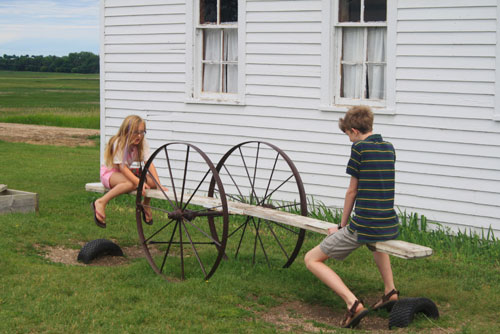
Breece: I didn’t think there was much in the building except for a covered wagon that you could climb into. There were lots of things to read on the wall and looked like the kind of thing that Mom (Rachael) and Nama would read every word of. So I went outside again until they called me back to take some photos.
Avery: The covered wagon looked pretty uncomfortable. Nama says that whole families would sleep in the wagon bed after they stopped traveling for the night. It was very narrow and I think I would have been squished. I think I would have felt squished in the next exhibit too. There was a dugout house and a wooden shack made of planks. The sign asked you to choose if you’d rather live in a dugout or shanty when you staked your prairie claim. I chose the shanty because the walls weren’t made of dirt, which seemed like it would be very hard to deal with on cleaning day.
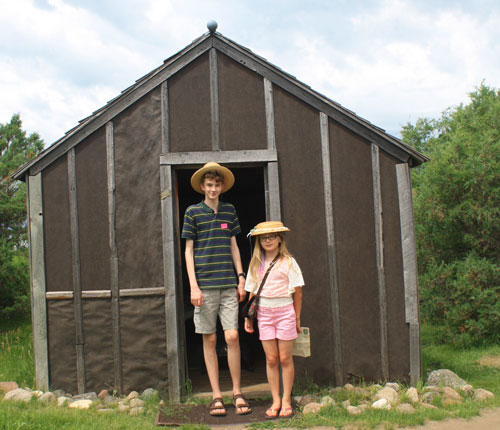
Breece: I chose the shanty too because the ceiling was higher. Nama picked the shanty as well because she is claustrophobic and even though the spaces were both very small, she felt less closed in when she was in the shanty. Mom was the only one to pick the dugout. She chose it for warmth and because it didn’t cost a lot of money to build.
Avery and I were ready to run to the hay barn next, but before we walked too far away from the car, we went and got our lunch and had a picnic next to one of the covered wagon tents they have here for camping. I’m glad we are not camping. The wagons are bigger than the shanty and dugout, but not much.
Avery: After lunch it started to rain a little bit so we went on the porch of the gift shop and found a kitten! It was licking the floor under a spigot so we thought it was very thirsty and turned the water on. We decided to go to the barn and ask about the kitten. But we got distracted when we saw the baby calf. It had a big lump on its face the size of a baseball. The person working in the barn said that it was a goiter that happens sometimes in calves but that it wasn’t harmful. She also told us that the next wagon ride to the schoolhouse was loading up and that we should get on.
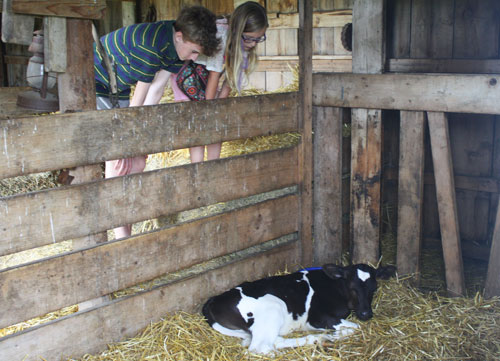
Two mules pulled the covered wagon. One mule was very gassy! The driver let some of the kids drive. One kid accidentally let the mule go on the grass. I got to drive, but just kind of sat there with the reins.
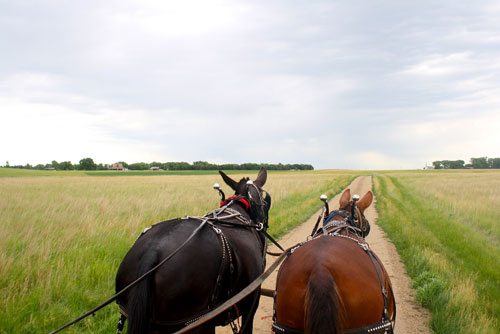
Once we got to the school, we dressed up in aprons and bonnets (for girls) and hats for boys and chose a desk. The teacher was really a teacher but instead of teaching us, she told us all about school in Laura’s day. For example, every day, the oldest boy had to go out and get the drinking water for the whole school.
Breece: I got to ring the bell to dismiss school and we rode back across the prairie in the wagon. The next thing to check out was called Ma’s Little House on the map. This wasn’t the exact house that Pa built on the homestead, but it was built to look just like it. I could see that Mom and Nama were going to spend a lot of time in here, so Avery and I did all the activities. I made a spinning toy moonspinner with a button and string and braided some material for a rag rug and played with the sewing machine.
Avery: Ma’s Little House seemed like the biggest place yet that the Ingalls lived in. It had more rooms and the rooms were larger. What I liked best though was outside the house. Outside you could wash clothes. You put the cloth in the washing machine, rubbed it with soap, and scrubbed it on the washboard. Then you put it through the wringer, rinsed it, put it through the wringer again, and hung it up to dry. It was fun to put it through the wringer and hang it up to dry. Washing clothes today is boring but easy. You wash so much at a time so all you have to do is fold it and put it away. Washing clothes with this machine was probably boring for Laura and her family. But since it was a one-time thing for me, it was really fun.
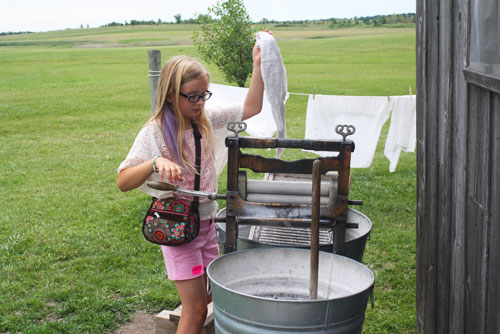
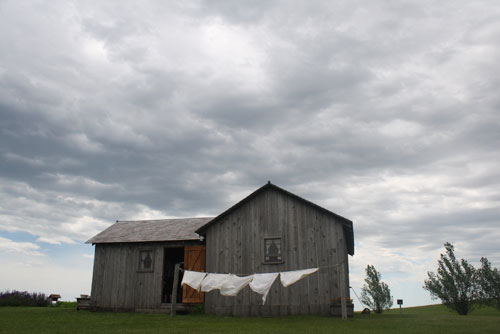
Breece: Avery washed clothes until even Mom and Nama were ready to move on. We walked over to a big barn and stable that had several horses and ponies. If you wanted to, you could ride a pony or drive a little cart pulled by a pony. I wasn’t sure if I wanted to, but Avery did, so I did it too. We each rode and drove a little ways, but the wrangler was always holding on to the animals too. It was okay. I had more fun when we went up in the loft of the barn where we could bounce around in old carriages and pretend drive.
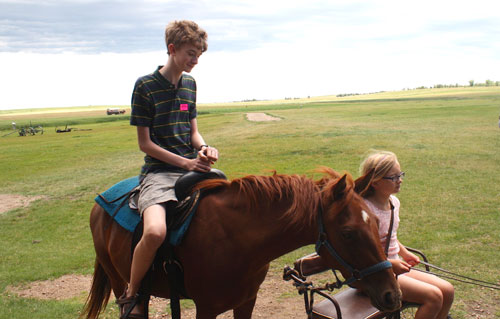
Avery: There were more kittens in the big barn, so we told the person working in the barn about the one we saw that was thirsty and she said she’d go and find it. The kittens are supposed to stay around the barn and she said it must have gotten lost.
The next stop on the homestead didn’t seem to belong. It was a garage. But there were cool activities in it. We braided rope and made jump ropes, dressed corncob dolls and then the lady showed us how to make hay twists. During the Long Winter, Pa and his family couldn’t get any coal so he and Laura had to sit out on the porch making hay twists, 300 a day! Sometimes Pa’s hand hurt so bad he couldn’t play the fiddle. Laura wore out her jacket because she had to tuck the hay under her arm because she was smaller than Pa. Twisting hay looks like really hard work.
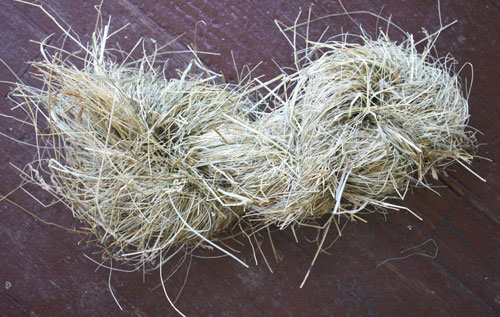
Breece: I liked making the rope and Avery and I skipped rope all the way to the church. The church wasn’t there when the Ingalls lived here. It is just here now to represent the role of churches in prairie life. It had an organ that I played, but there wasn’t much else to do so I went back on the prairie with my rope. Mom came with me and we talked about taking the trail through the slough, but it was already going to be a pretty long walk back to the car and we’d already ridden by the slough on the wagon ride to the school. I was ready to head back.
___
There was still one spot left on the homestead that we hadn’t visited so while Avery, Breece and Janet were shopping in the gift shop, I walked down a little hill toward a small grove of trees near the road. The trees were fenced off and I wondered why until I circled around and saw that this was the Laura Ingalls Wilder Memorial site and the trees were five of the original cottonwoods that Pa had planted on the homestead claim. They were old, interesting looking trees. Compared to all the other things we’d seen and done, they shouldn’t have seemed like much. But in that quiet moment with Pa’s last living cottonwood trees, history was alive and I felt fulfilled and content.
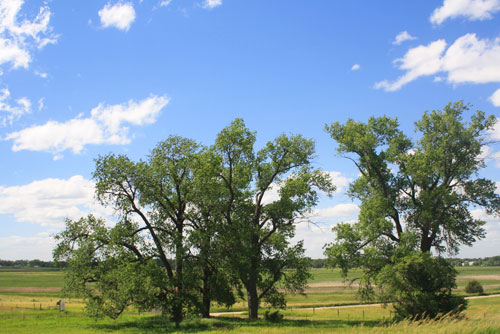
About the Author
Join children’s literacy consultant Rachael Walker and many of the authors, parents, and educators she’s met and worked with to talk about how books have changed their lives, how to bring books to life for young readers, and how to enrich kids’ lives with good books.
